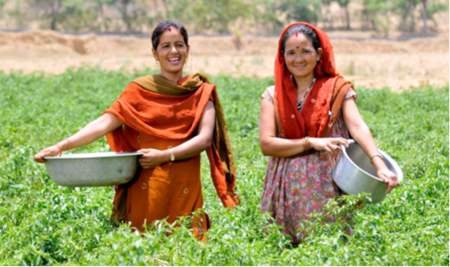Gender and digital inclusion
To involve women in the service development is a clear mission for the projects. Women should be active participants in the development and implementation of the digital services. Many times there is a clear business case for investing in active participation of women in agriculture, as reaching a large number of women farmers will create more impact. Aiming to maximize digital inclusiveness of the product will thus not only increase the social impact of services, but will also increase potential sales and will make it easier to create a sustainable business models. Differences in needs and possibilities of women should be specifically addressed. This includes an understanding of the activities that women perform and the limitations that they face.
Financial access and the ability to decide how to spend money is an important enabler to follow the advice provided by services (e.g. buying and applying nutrients). A good understanding of the impact that the selection for service delivery methods has on digital inclusion is also important. Differences in access to mobile phones (feature phones and smart phones) and in (digital) literacy will result in variation of uptake amongst different groups. Digital literacy (the ability to use ICT tools) is generally higher for younger people and especially for men. In developing countries, women are 25% less likely to be online compared to men, and also have a lower literacy level (75% vs 86%) [1]. One of the important reasons that stops women from buying mobile phones (after affordability and literacy/skills) is that the family does not approve of this [2].
In systems with cash crops, the use of digital tools is higher [3] as the benefit to cost ratio is better. As men focus more on cash crops, while women tend to focus on legumes, vegetables and other crops for home-consumption [4], the focus crops of the services will also impact the uptake by women. The distribution of household- and farming tasks between men and women also result in differences in daily schedules: aiming to reach farmers by radio or TV should take this daily routines into account (gender-differentiated programming) [5].
An overall requirement for the success of digital tools in agricultural extension is related to network access. While almost any service delivery method can be used to provide information, network coverage is in most cases a prerequisite. Limited network coverage impact men and women equally, but is mainly limiting to already marginalized groups. Marginalized groups often live in remote areas where using networks is restricted by either physical absence of required infrastructure or the financial costs associated with the use. The political bias in internet provisioning results in limited inclusion of marginalized ethnic groups [6]. The publications on this page may help projects to include gender more prominently into their development and businesses.

The following reports are meant to present the latest insights on women and farming, share best practices, and provide practical suggestions on how women farmers can be included in projects as active participants.
- Report "Including women smallholder farmers: a business case for success"
A gender approach in using satellite data for agriculture in developing countries
The database Partners for Women lists several organisations in G4AW countries that have their core business in gender:
The GSMA Connected Women programme works with mobile operators and their partners to address the barriers to women accessing and using mobile internet and mobile money services. Connected Women aims to reduce the gender gap in mobile internet and mobile money services and unlock significant commercial opportunities for the mobile industry and socio-economic benefits for women.
- Read the Mobile Gender Gap Report
Inclusive finance and the role of women:
The role of women in agricultural production and value chains should not be underestimated. In many countries the focus of microfinance is put on women because of their impact on the wellbeing of the family as a whole. Gender norms and values, as well as the work burden of women still are a hindrance to women to optimally benefit from loans, even if they are available. Thus they benefit more if additional services are provided to develop their businesses, alongside with the loan. This can range from financial literacy courses to business development support. Tailored services to the cultural and gender norms such as female extension officers, group savings, etc. can be additionally beneficial in reaching women smallholders specifically [1].
Read more:
- Digital literacy in the developing world: a gender gap
- Mobile Gender Gap Report, 2020
- The role of ICT expenditure for cash crop production and income generation in Southern Ethopia
- FAO: Gender and Development Plan of Action
- Rural radio in agricultural extension: the example of vernacular radio programmes on soil and water conservation in Northern Ghana
- Digital discrimination: Political bias in Internet service provision across ethnic groups
- The Impact of Digital Services on Women Smallholder Farmers